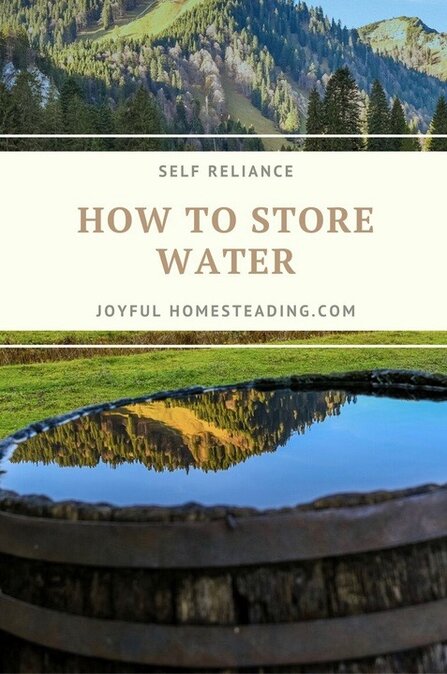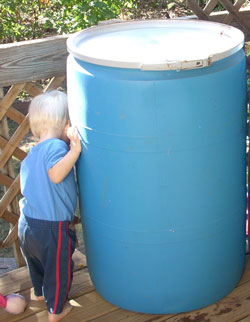How to Store Water
How to store water is one of the first things to learn when preparing for emergencies. On average, water makes up about 60 percent of our bodies. It is basic to our survival. Without it, we will die. The only thing more crucial to our survival is oxygen.

Photo by Zotx at Pixabay
Not only do we need water physically, we also need it for cooking, bathing and washing dishes. In an emergency, water is the most important thing to have on hand.
As people in third world countries can attest, finding a source of fresh, clean water is a challenge. For those of us in the western world, spoiled by city water systems that pipe water in, finding water in an emergency if those water systems shut down, will be next to impossible.Learn how to store water now. I'm saying it again because it's so important. Learn how to store water and start storing water now. Even if you never use it, the peace of mind will be well worth the minimal effort and expense.

How Much Should
You Store?
You should store two gallons of water for each family member per day. It is wise to have a two week supply of water storage on hand, or 14 gallons of water per family member. For my family of five, that means we should have at the very least, 70 gallons of water on hand.
How to Store Water
What Kind of Water Do You Store?
Store water you are used to drinking. For most of us, that means the water that comes straight from our tap should go into our water storage. Children find comfort in consistency. In an emergency situation where stress levels are high you will want your food and drinking water to taste like it would under normal circumstances.
What Should You
Store It In?
Store your water in heavy-duty, plastic containers with tight-fitting lids. Make sure your water storage containers are completely clean. Plastic containers are lighter and wont break like glass containers will.
Water weighs about 8 pounds per gallon, so a five gallon water storage container weighing in at 40 pounds is the most you will probably be able to carry. If your storage space is small, limit the size of your containers to between one and five gallons.
It is better to buy new containers rather than used ones, and obviously, if you do choose to store water in your used containers, know what those containers previously held. Be aware that containers that previously held milk, fruit juice, food items, or worse, chemicals, will retain a residual taste and smell of those items. If you store water in these used containers, it will eventually contaminate your water. The molecules in water easily pick up even the slightest molecules from other sources. An important thing to know when learning how to store water is that New containers are always your best choice.
Avoid Metal Containers
Water makes metal rust, and rust makes water nasty. Plus, metal is heavy. So when learning how to store water, remember to just say no to metal, or if you must use metal containers for your water storage, use the ones with enamel coating.
How Long Can
You Keep Water?
If your water is free from bacteria then it will last for years. However, to be safe, it is best to rotate your water storage. Change it out every six months. Rotate your containers, changing out the water and putting the containers with the fresher water at the back of your shelf and the older water up front. Get into the habit of changing out the water in a few of your containers every month and rotate them. The few minutes you invest in this each month will be well worth the peace of mind you'll have.
How to Store Water and
The Dangers of Contaminated Water
If you drink or cook with contaminated water, anything could happen from a mild case of diarrhea, to a more serious illness such as dysentery, typhoid or hepatitis. You could even die. Clean water for your water storage is just that crucial. Any time you find water from a questionable source, assume it is contaminated.
What If There Is No Clean Water?
What if the worst happens and you have no clean water? Here are some ways you can treat contaminated water:
Boil It
Boiling water is the cheapest and safest way to treat water. You must boil it for at least 10 minutes and it must reach 212 degrees Fahrenheit or 100 degrees Celsius at sea level. This will kill the bacteria and harmful life in the water. The boiling method is cheap, easy and relatively quick; it produces drinkable water in ten minutes. The downside is, it won't taste as good. Plus you might not have access to a fire. Or you might not want to waste that much fuel. Also, your water may have debris in it. Still, this is a viable way to go.
Bleach It
You can treat water from an unknown source with bleach that contains a 5.25 percent solution of sodium hypochlorite. Make sure sodium hypochlorite is the only active ingredient in the bleach you use. You dont want soap additives or phosphates in your water. If your pretreated water is clear, add 2 drops of bleach for every quart of water. If the water is cloudy, add 4 drops for every quart of water. Make certain the bleach is thoroughly mixed and then let the mixture stand for 30 minutes.










New! Comments
Have your say about what you just read! Leave me a comment in the box below.